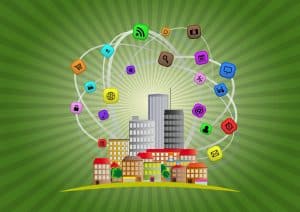
Interest in using AI to manage buildings is on the rise because it can help lower costs during an economic downturn and reduce carbon emissions.
Honeywell and SAP this week announced they will integrate their respective cloud platforms to enable organizations to manage buildings and other facilities more efficiently.
As one of the primary suppliers of heating, ventilation, and air conditioning (HVAC) systems, Honeywell has invested in a Honeywell Forge cloud platform that employs sensors and artificial intelligence (AI) to enable building owners to better control costs, reduce carbon footprints, and enforce social distancing mandates to combat the spread of the COVID-19 pandemic.
See also: TIA and IoT Community Team Up to Smarten Buildings
SAP provides an SAP Cloud for Real Estate application that enables organizations to analyze data collected from multiple facilities to, for example, optimize occupancy rates.
The two companies have committed to normalizing and harmonizing data across both these cloud-based offerings to make it simpler to create dashboards through which key performance indicators can be monitored.
This joint solution is the first in a series the two companies are planning that will leverage platforms that each company has developed for various vertical industry segments, says David Trice, vice president and general manager for Honeywell Connected Buildings.
In general, Trice says the alliance with SAP stems from a decision by Honeywell to replace all its physical systems with a virtual control system based on software. That approach allowed Honeywell to build cloud applications to manage buildings remotely. Honeywell is now in a position to extend the scope of that effort via application programming interfaces (APIs) to create an ecosystem around that core capability, said Trice.
“We’ve adopted standard technologies,” says Trice.
In addition to collaborating on additional initiatives with SAP, Trice says business and IT leaders should expect to see Honeywell collaborating with other providers of enterprise applications as well.
Interest in applying AI to manage buildings is on the rise of two reasons. The first is lower costs during an economic downturn. That effort also brings with it the added benefit of reducing carbon emissions. Honeywell claims is AI-infused cloud platform can reduce energy costs by as much as 23% based on pilot implementations of Honeywell Forge.
However, as more employees return to office buildings in the wake of the COVID-19 pandemic, it’s also becoming apparent there will be a need to make sure social distancing policies within an office are being followed. Sensors, for example, can track how many people might be crammed into a conference room at the same time.
Whatever the motivation, buildings are becoming more intelligent as sensors are embedded in everything from elevators to temperature control devices. All the data those sensors collect can then be shared with analytics applications infused with machine and deep learning algorithms that might be running locally or in the cloud. Armed with that analytics, building managers can then make more informed decisions to control both costs and access.
It may be a while before every building is instrumented to the point where analytics are routinely employed to contain costs and implement healthcare policies. However, it’s also apparent the urgency associated with achieving those twin goals has for all concerned substantially increased.





























